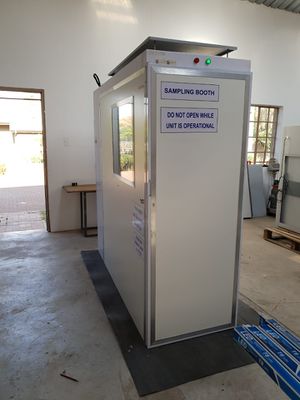Difference between revisions of "Guidelines for safe sputum collection"
(formatting for →Engineering control measures for sputum collection) |
m (Categories added) |
||
| Line 8: | Line 8: | ||
There are two main types of engineering methodologies that can be utilized for sputum collection; local exhaust ventilation devices and sputum induction rooms. | There are two main types of engineering methodologies that can be utilized for sputum collection; local exhaust ventilation devices and sputum induction rooms. | ||
| − | === Local exhaust ventilation devices === | + | ===Local exhaust ventilation devices=== |
Local exhaust ventilation devices capture of airborne contaminants at or near the source before they are dispersed into the work space [4,5]. The basic components of an LEV device are hood, ductwork, air cleaner and fan [5]. Burgess, et al., [4] identifies two major categories of LEV devices; enclosures and exterior. The major difference between these two is that for enclosures, contaminants are released from inside the device whereas for exterior contaminants are released outside the device. A sputum booth is considered as an example of an enclosure LEV device. Illustrations of an enclosure and exterior LEV devices are shown in Figures 1 and 2 respectively. Figure 1 shows a CSIR designed sputum booth. Technical specifications for the booth that can be used for procurement are included in Appendix A. | Local exhaust ventilation devices capture of airborne contaminants at or near the source before they are dispersed into the work space [4,5]. The basic components of an LEV device are hood, ductwork, air cleaner and fan [5]. Burgess, et al., [4] identifies two major categories of LEV devices; enclosures and exterior. The major difference between these two is that for enclosures, contaminants are released from inside the device whereas for exterior contaminants are released outside the device. A sputum booth is considered as an example of an enclosure LEV device. Illustrations of an enclosure and exterior LEV devices are shown in Figures 1 and 2 respectively. Figure 1 shows a CSIR designed sputum booth. Technical specifications for the booth that can be used for procurement are included in Appendix A. | ||
[[File:Mechanical sputum booth.jpg|none|thumb|Mechanical sputum booth]] | [[File:Mechanical sputum booth.jpg|none|thumb|Mechanical sputum booth]] | ||
| Line 14: | Line 14: | ||
==References== | ==References== | ||
<references /> | <references /> | ||
| + | [[Category:Sputum Collection]] | ||
| + | [[Category:Ventilation]] | ||
| + | [[Category:Airborne Contamination Control]] | ||
| + | [[Category:Articles to be expanded]] | ||
| + | [[Category:TB-IPC]] | ||
Revision as of 17:33, 18 June 2020
Please help to expand this page. The reason given is: Article still under active review |
Contents
Introduction
Sputum specimen examination is the main diagnostic procedure for pulmonary Tuberculosis [1]; however, the medical procedure (patient coughing) that is used for sputum collection increases the potential for transmission of M. Tuberculosis significantly [2]; therefore, there is need to administer sputum collection safely in healthcare facilities [3]. The CSIR’s Infrastructure Innovation research group has conducted many TB risk assessments in South African public healthcare facilities for over 10 years. A common finding was that engineering controls for sputum collection were not always adequate, maintained or monitored. Sputum was observed to be collected from toilets, consulting rooms and counselling rooms which implies increased risk of TB transmission. This guideline provide guidance on conducting sputum collection safely for suspected or known infectious TB patients. Although there is a three level hierarchy of control measures; administrative controls, engineering controls and personal respiratory protection to prevent transmission of TB, this guideline is limited to engineering control measures for sputum collection.
Engineering control measures for sputum collection
There are two main types of engineering methodologies that can be utilized for sputum collection; local exhaust ventilation devices and sputum induction rooms.
Local exhaust ventilation devices
Local exhaust ventilation devices capture of airborne contaminants at or near the source before they are dispersed into the work space [4,5]. The basic components of an LEV device are hood, ductwork, air cleaner and fan [5]. Burgess, et al., [4] identifies two major categories of LEV devices; enclosures and exterior. The major difference between these two is that for enclosures, contaminants are released from inside the device whereas for exterior contaminants are released outside the device. A sputum booth is considered as an example of an enclosure LEV device. Illustrations of an enclosure and exterior LEV devices are shown in Figures 1 and 2 respectively. Figure 1 shows a CSIR designed sputum booth. Technical specifications for the booth that can be used for procurement are included in Appendix A.
